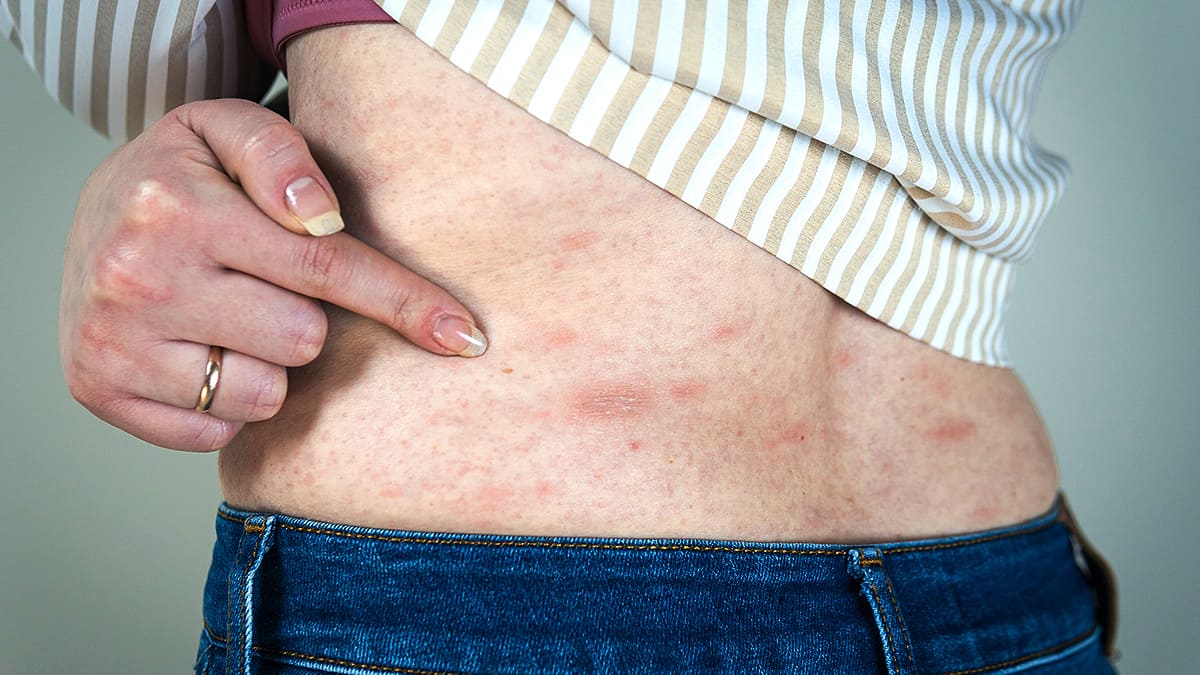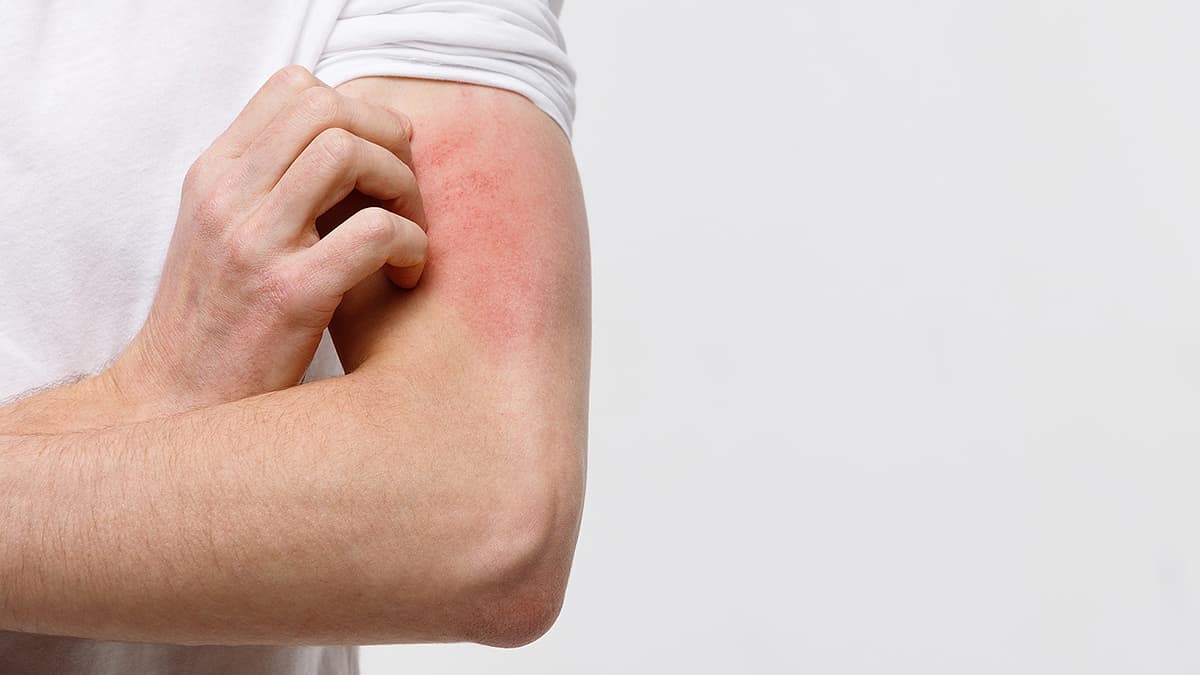Acute and Chronic Hives and Rashes: Causes and Treatments
Physical Health

There are many different conditions that can cause bumps, rashes, or itchy skin. In many cases, the conditions are temporary and quickly disappear with treatment. In other cases, hives or rashes can last long-term and are more difficult to manage. Your primary care physician or a dermatologist can help diagnose skin conditions and recommend a proper treatment plan. (For more on dermatological issues, see my article on how to treat skin conditions; eczema, seborrhea and psoriasis.)
Acute vs. Chronic
When diagnosing and treating skin problems, it helps to know whether the condition is acute or chronic. Acute conditions appear quickly and often within a few days. The skin’s appearance may change within a day or two, overnight, or even within a few minutes. Symptoms may also get worse fast.
On the other hand, chronic conditions are present for several weeks or longer and they may tend to worsen over a longer time period. Chronic conditions may appear on their own or may develop as a result of acute skin conditions that go untreated.
What Are Hives?
Hives are bumps that stick out from the skin. These bumps, also called urticaria or wheals, are itchy and usually appear red in color, although this redness can be harder to see on darker skin colors. Hives may also appear as flat, raised patches on the skin. The bumps and patches may grow larger, change shape, or go away over a short time period. Hives are common, affecting up to 1 in 5 people at some point in their lifetime.
Hives are usually caused by an allergic reaction. When a person comes in contact with something they are allergic to, the immune system creates inflammation, which may lead to hives and swelling. Things that may create an allergic response and lead to hives include:
- Pollen, mold, or dust
- Bug bites
- Animals, including cats or dogs
- Foods, including nuts, dairy products, eggs, meat, or seafood
- Chemicals such as latex
- Certain soaps, detergents, or cosmetic products
- Medications such as aspirin, penicillin, vitamins, birth control pills, and non-steroidal anti-inflammatory drugs (NSAIDs)
Hives aren’t always an allergic reaction. Sometimes, they form when a person is feeling stressed, sweats a lot, exercises, or has been in very hot or very cold temperatures. Infections like mononucleosis (mono), sinus infections, tooth infections, or COVID-19 can also lead to hives. Another possible cause is diseases like lupus, thyroid disorders, or lymphoma. In some cases, doctors don’t know what has caused a particular case of hives.
Hives can be acute or chronic. Acute hives usually appear and disappear within a period of hours or days. They may come back over the next couple of weeks, but will usually go away again quickly. Chronic hives continue to reappear, sometimes multiple times per week, over a period of 6 weeks or more.
Treating Acute Hives
Acute hives often disappear without any treatment. To help the skin recover, you can avoid hot water and tight-fitting clothing. Antihistamine (anti-allergy) medication can help calm these allergic reactions. Severe hives may need to be treated with stronger medication or a shot.
Allergens can sometimes cause a severe allergic response called anaphylaxis. You may need emergency medical care if hives appear along with a tightening of the mouth or throat, swelling in the face, breathing problems, or fainting.
It is important to figure out the cause of hives. When they are triggered by a particular substance, avoiding that substance in the future can help prevent hives. Your doctor can help you determine if you are allergic to any foods, medications, or other substances, or are sensitive to another factor such as heat or sunlight.
What Causes Chronic Hives?
In about 80 to 90% of cases, doctors aren’t sure what caused chronic hives. They call these cases “idiopathic.” Some doctors think that idiopathic chronic hives may result from an autoimmune reaction in which the immune system attacks the body’s healthy tissue. One of the most common triggers of chronic hives is physical factors like pressure, water, vibration, or extreme temperatures. These factors may make hives appear or cause existing hives to get worse.
In some cases, chronic hives can be a signal of an underlying disease, such as an infection or thyroid disorder. For this reason, it is a good idea to talk to your physician if you are experiencing chronic hives. However, having an underlying disease is rare, and most cases of chronic hives are caused by some other factor.
Chronic Hives: Treatments
Generally, the first step in treating chronic hives is to use a type of medication called second-generation H1 antihistamines. These medications include:
- Claritin (loratadine)
- Clarinex (desloratadine)
- Zyrtec (cetirizine)
- Xyzal (levocetirizine)
- Allegra (fexofenadine)
If these medications don’t get chronic hives under control, doctors may recommend other strategies. This may include taking a higher dose of the same medication or trying other types of allergy medications. If these strategies are ineffective, people with chronic hives may be able to take immunosuppressive drugs (medications that calm down the immune system). Additionally, doctors may recommend steroid drugs for people with severe chronic hives.
Some complementary medicine approaches may also help. Chronic hives symptoms may come on less frequently and for shorter amounts of time when people undergo acupuncture treatments. Because stress can worsen hives, mental health therapies like hypnosis, relaxation exercises and other natural methods to boost one’s mood may also help treat chronic hives.
For a little over 1 in 3 people with chronic hives, symptoms disappear within a year. For others, symptoms may continue off and on for several years or for their entire life.
Rashes and Their Causes

A rash is any change in the appearance or feeling of the skin. Rashes may appear as small or large bumps or blisters, patches of cracked or peeling skin, a scaly appearance, or areas of swollen or irritated skin. Rashes may be red, skin-colored, or look darker than the skin around them. They may feel itchy, painful, or neither. Rashes may appear and clear up slowly or quickly.
Rashes may have many causes, including:
- Infections in the skin or throughout the body
- Contact with certain chemicals, cosmetic products, or other items that you are sensitive to
- Insect bites
- Contact with a plant like poison ivy or poison oak
- Disorders such as rheumatoid arthritis or Kawasaki disease
Like hives, other types of rashes can also be caused by an allergic reaction or by an immune system response. Contact dermatitis is a form of eczema. It leads to a rash that usually appears red or inflamed. These rashes may be painful. Contact dermatitis appears when the skin touches something that irritates it.
Another common rash is atopic dermatitis. Experts don’t yet understand what causes this condition, but have found that genetics may play a large role. Atopic dermatitis is also linked to an abnormal response by the immune system.
It can be difficult to tell apart different types of rashes. If you have a rash that isn’t improving or is getting worse, you may need to get the rash diagnosed by your primary care doctor or a dermatologist. Doctors can perform various tests to help determine the cause. Tests may include blood tests or a biopsy, in which a small sample of skin is removed and studied under a microscope.
Treating Rashes
Many rashes can be treated at home. One important part of managing rashes is practicing good skin care. Things like using moisturizer every day can help keep eczema under control. Products with an oil, cream, or petroleum jelly base may work best to lock in moisture. You may need to try a couple of different products before you find one that works well for you. It’s probably best to avoid using lotions and creams that contain fragrances.
Many rashes appear or get worse when the skin touches certain triggers. See if you can recognize whether using a certain product or coming into contact with a chemical or metal makes your rash worse. Your doctor may also be able to give you a patch test, in which patches containing different materials are placed on the skin to see if they cause a reaction. This can help you figure out if you’re allergic or sensitive to a particular substance.
When treating rashes at home, you may want to try:
- Avoiding covering the rash with a bandage or clothing, if possible
- Cleaning your skin with gentle soap or body washes such as Dove
- Being gentle with your skin while washing or drying it — try patting, rather than scrubbing
- Taking a bath with products that contain oatmeal
- Using over-the-counter creams like hydrocortisone for irritation or itching, or calamine lotion for rashes caused by plants like poison ivy
- Taking an antihistamine pill or tablet
Most rashes are mild and can be treated with home remedies. However, some rashes are more serious or are a sign of an underlying health condition. I urge you to see your physician if you have a rash that is very painful or forms blisters. Additionally, watch out for rashes that may be signs of infection. These rashes may feel warm, release yellow or green fluid, be surrounded by red streaks, or be accompanied by a fever.
More serious rashes may require more aggressive treatment. Your physician can prescribe creams or ointments that contain higher doses of steroids or other medications than are available in over-the-counter products. Rashes caused by infections need to be treated with additional medications, such as antibiotics or antiviral drugs. Additionally, if a rash is caused by another health condition, you will need to treat the underlying disorder.
Can Diet Help Treat Hives or Rashes?

Dietary changes may help improve chronic hives. Some people with this condition have celiac disease, a disorder in which a person’s body can’t tolerate gluten. If you notice that your hives tend to get worse after eating products that contain wheat, barley, or rye, you may want to see if your doctor can test you for celiac disease. Additionally, some people with chronic hives have a vitamin D deficiency, so taking supplements may help improve symptoms.
Some studies have found that more than one out of three people who follow certain elimination diets see an improvement in their chronic hives. One of these diets is a pseudoallergen-free (PAF) diet. During a PAF eating plan, a person identifies and eliminates foods that lead to an immune system reaction. Chronic hives patients may be sensitive to foods like tomatoes, seafood, herbs, alcohol, or artificial preservatives or dyes.
People with chronic hives may also feel better when they eat a histamine-free diet. Histamine is a molecule that is normally made by the immune system during an allergic reaction. However, histamine is also found in certain foods. If you want to try a histamine-free diet, you will have to avoid foods like:
- Certain fish, such as tuna, anchovy, and mackerel
- Chicken, pork, and preserved meats like sausage and ham
- Certain vegetables (spinach, eggplant, and tomatoes)
- Citrus fruits, strawberries, cherries, and any dried fruits
- Fermented foods like yogurt, aged cheeses, wine, beer, and kimchi
- Processed foods, including fast food, canned food, and pre-packaged foods
Changing your diet may also help if you have contact dermatitis or atopic dermatitis. People with these conditions may be sensitive to certain foods. This may not result in a typical allergic reaction. Instead, people may develop dermatitis after eating a particular food. It is not always easy to figure out which food is causing a reaction, since the dermatitis may not appear for hours or days after the food was eaten. The best way to determine whether a food is causing dermatitis may be to go through testing in a doctor’s office.
If you are interested in trying a diet to help with skin problems, consult with your physician, a Registered Dietician (RD), or a Certified Nutrition Specialist (CNS). These health care practitioners can help you make sure you’re still getting the nutrients you need if you cut out certain foods from your diet.
Conclusion
Many cases of hives and rashes are mild. Practicing good skin care and being gentle with your skin may help a skin problem from getting worse. Additionally, some dietary changes may help soothe hives or rashes. However, you should always talk to your physician if home treatments don’t seem to be working or if you can’t figure out what is causing a skin condition.